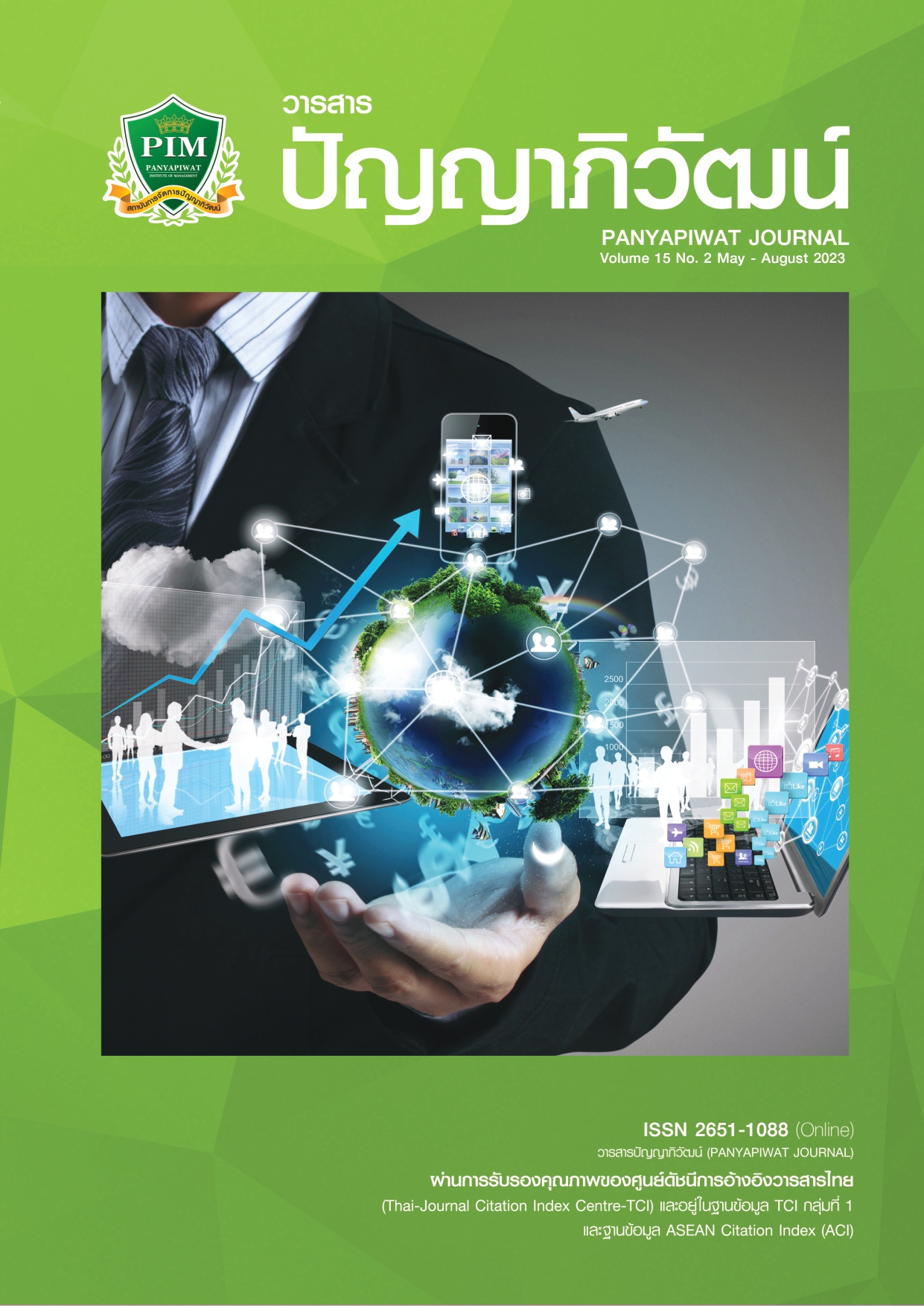EXPLORING TECHNOLOGY ACCEPTANCE OF OCEAN NETWORK EXPRESS WEBSITE BY LOGISTICS EMPLOYEES IN BANGKOK
Main Article Content
บทคัดย่อ
The use of the Ocean Network Express website by logistics department employees is a crucial research topic that can explain the success or failure of any transportation application. This study employs a substantial body of literature on a modified version of the Technological Acceptance Model (TAM) as its theoretical foundation. As a result, the goal of this study is to gain a better understanding of the factors that affect the user’s intention to utilize the Ocean Network Express website.
The proposed research model consists of TAM and three external factors which were chosen after a review of the literature. This is a quantitative study in which the data is collected and analyzed statistically by a Partial Least Square regression (PLS). Google Form was used to conduct an online survey of 400 Bangkok based logistics workers who have used the Ocean Network Express website in the past. The effects of TAM characteristics and external factors (such as trust, innovativeness, and work relevance) on intention to use were investigated. Trust, innovativeness, and job relevance all had statistically significant effects on perceived ease of use and usefulness at p >.05. Furthermore, the perceived ease of use and perceived usefulness of the company’s website directly predicted the intention to use. According to the current findings, the original TAM strategy should be updated to provide better insights into how to boost employee adoption and use of the website.
When designing any transportation application, the web developer should prioritize perceived ease of use and user satisfaction to ensure its effectiveness and utility for consumers. These findings can also assist logistics companies and entrepreneurs in successfully integrating technology into their operations.
Article Details

อนุญาตภายใต้เงื่อนไข Creative Commons Attribution-NonCommercial-NoDerivatives 4.0 International License.
“ข้าพเจ้าและผู้เขียนร่วม (ถ้ามี) ขอรับรองว่า บทความที่เสนอมานี้ยังไม่เคยได้รับการตีพิมพ์และไม่ได้อยู่ระหว่างกระบวนการพิจารณาลงตีพิมพ์ในวารสารหรือแหล่งเผยแพร่อื่นใด ข้าพเจ้าและผู้เขียนร่วมยอมรับหลักเกณฑ์การพิจารณาต้นฉบับ ทั้งยินยอมให้กองบรรณาธิการมีสิทธิ์พิจารณาและตรวจแก้ต้นฉบับได้ตามที่เห็นสมควร พร้อมนี้ขอมอบลิขสิทธิ์บทความที่ได้รับการตีพิมพ์ให้แก่สถาบันการจัดการปัญญาภิวัฒน์หากมีการฟ้องร้องเรื่องการละเมิดลิขสิทธิ์เกี่ยวกับภาพ กราฟ ข้อความส่วนใดส่วนหนึ่งและ/หรือข้อคิดเห็นที่ปรากฏในบทความข้าพเจ้าและผู้เขียนร่วมยินยอมรับผิดชอบแต่เพียงฝ่ายเดียว”
เอกสารอ้างอิง
An, S., Eck, T., & Yim, H. (2023). Understanding consumers’ acceptance intention to use mobile food delivery applications through an extended technology acceptance model. Sustainability, 15(1), 832. https://doi.org/10.3390/su15010832
Al-Azawei, A., & Alowayr, A. (2020). Predicting the intention to use and hedonic motivation for mobile learning: A comparative study in two Middle Eastern countries, technology in society 62.
https://doi.org/10.1016/j.techsoc.2020.101325
Chalutz Ben-Gal, H. (2023). Artificial Intelligence (AI) acceptance in primary care during the coronavirus pandemic: What is the role of patients’ gender, age and health awareness? A two-phase pilot study. Front Public Health. https://doi.10.3389/fpubh.2022.931225
Chin, W. W. (1998). The partial least squares approach to structural equation modeling. Modern Methods for Business Research, (2), 295-336.
Davis, F. (1989). Perceived usefulness, perceived ease of use, and user acceptance of information technology. MIS Quarterly, (3), 319-340.
Fornell, C., & Larcker, D. F. (1981). Evaluating structural equation models with unobservable variables and measurement error. Journal of Marketing Research, 18(1), 39-50.
Ghozali, I., & Latan, H. (2015). Partial least squares. Konsep, Teknik dan Aplikasi Menggunakan Program SmartPLS (3).
Green, S. (1991). How many subject does it take to do a regression analysis? Multivariate Behavioral Research, 26(3), 499-510. https://doi.10.1207/s15327906mbr2603_7
Kenton, W. (2022, December 29). Logistics. Investopedia. https://www.investopedia.com/terms/l/logistics.asp#:~:text=Logistics%20refers%20to%20the%20overall,transported%20to%20their%20final%20destination.&text=The%20term%20is%20now%20used,moved%20along%20the%20supply%20chain
Ketikidis, P., Dimitrovski, T., Lazuras, L., & Bath., P. A. (2012). Acceptance of health information technology in health professionals: An application of the revised technology acceptance model. Health Informatics Journal, 18(2), 124-134. https://doi.10.1177/1460458211435425
MacCallum, R. C., Widaman, K. F., Zhang, S., & Hong, S. (1999). Sample size in factor analysis. Psychological Methods, 4(1), 84-99. https://doi.org/10.1037/1082-989X.4.1.84
Molla, A., & Licker, P. S. (2005). E-commerce adoption in developing countries: A model and instrument. Information & Management, 42(6), 877-899. http://dx.doi.org/10.1016/j.im.2004.09.002
Nixon, G. (2019). 10.1 Technology acceptance model. OSU Library. https://open.library.okstate.edu/foundationsofeducationaltechnology/chapter/2- technology-acceptance-model/
Parasuraman, A., & Colby, C. L. (2001). Techno-ready marketing: How and why your customers adopt technology. The Free Press.
Shuhaiber, A., & Mashal, I. (2019). Understanding users’ acceptance of smart homes. Technology in Society, (58), 101110. https://doi.org/10.1016/j.techsoc.2019.01.003
Taber, K. T. (2018). The use of cronbach’s alpha when developing and reporting research instruments in science education. Research in Science Education, (48), 1273-1296. https://doi.org/10.1007/s11165-016-9602-2
Taufik, N., & Hanafiah, M. H. (2019). Airport passengers’ adoption behaviour towards self-check-in Kiosk Services: The roles of perceived ease of use, perceived usefulness and need for human interaction. Heliyon, 5(12), e02960. https://doi.org/10.1016/j.heliyon.2019.e02960
Teo, T., & Zhou, M. (2014). Explaining the intention to use technology among university students: a structural equation modeling approach. Journal of Computing in Higher Education, (26), 124-142. https://doi.org/10.1007/s12528-014-9080-3
Vărzaru, A. A., Bocean, C. G., Rotea, C. C., & Budică-Iacob, A. F. (2021). Assessing antecedents of behavioral intention to use mobile technologies in e-commerce. Electronics 2021, 10(18), 2231. https://doi.org/10.3390/electronics10182231
Venkatesh, V., Morris, M. G., Davis, G. B., & Davis, F. D. (2003). User acceptance of information technology: Toward a unified view. MIS Quarterly, 27(3), 425-478. https://doi.org/10.2307/3003654


